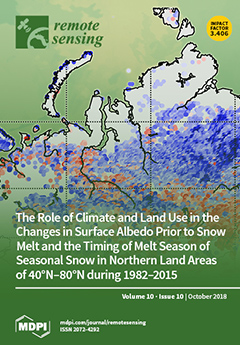Solar-induced chlorophyll fluorescence (SIF) is closely linked to the photosynthesis of plants and has the potential to estimate gross primary production (GPP) at different temporal and spatial scales. However, remotely sensed SIF at a ground or space level is usually instantaneous, which cannot represent the daily total SIF. The temporal mismatch between instantaneous SIF (SIF
inst) and daily GPP (GPP
daily) impacts their correlation across space and time. Previous studies have upscaled SIF
inst to the daily scale based on the diurnal cycle in the cosine of the solar zenith angle (
) to correct the effects of latitude and length of the day on the variations in the SIF-GPP correlation. However, the important effects of diurnal weather changes due to cloud and atmospheric scattering were not considered. In this study, we present a SIF upscaling method using photosynthetically active radiation (PAR) as a driving variable. First, a conversion factor (i.e., the ratio of the instantaneous PAR (PAR
inst) to daily PAR (PAR
daily)) was used to upscale in-situ SIF measurements from the instantaneous to daily scale. Then, the performance of the SIF upscaling method was evaluated under changing weather conditions and different latitudes using continuous tower-based measurements at two sites. The results prove that our PAR-based method can reduce not only latitude-dependent but also the weather-dependent variations in the SIF-GPP model. Specifically, the PAR-based method gave a more accurate prediction of diurnal and daily SIF (SIF
daily) than the
-based method, with decreased relative root mean square error (RRMSE) values from 42.2% to 25.6% at half-hour intervals and from 25.4% to 13.3% at daily intervals. Moreover, the PAR-based upscaled SIF
daily had a stronger correlation with the daily absorbed PAR (APAR) than both the SIF
inst and
-based upscaled SIF
daily, especially for cloudy days with a coefficient of determination (R
2) that increased from approximately 0.5 to 0.8. Finally, the PAR-based SIF
daily was linked to GPP
daily and compared to the SIF
inst or
-based SIF
daily. The results indicate that the SIF-GPP correlation can obviously be improved, with an increased R
2 from approximately 0.65 to 0.75. Our study confirms the importance of upscaling SIF from the instantaneous to daily scale when linking SIF with GPP and emphasizes the need to take diurnal weather changes into account for SIF temporal upscaling.
Full article





